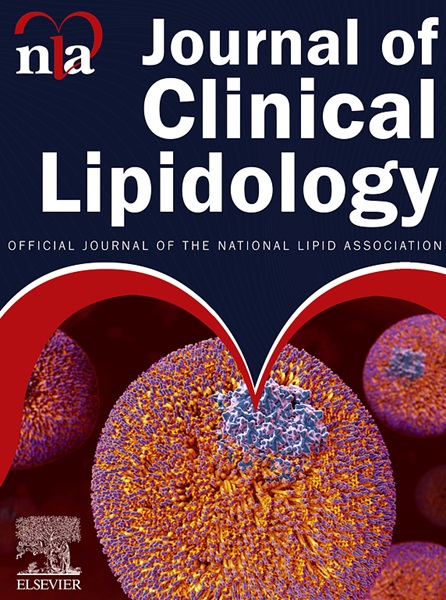Associations of serum omega-6 polyunsaturated fatty acids with apolipoprotein B and atherogenic lipoprotein lipids
IF 4.6
3区 医学
Q2 PHARMACOLOGY & PHARMACY
引用次数: 0
Abstract
Funding
The Indiana University Foundation funded this research.
Background/Synopsis
Observational evidence supports associations between higher intakes of omega-6 polyunsaturated fatty acids (PUFAs) and reduced risk for atherosclerotic cardiovascular disease. Serum levels of total omega-6 PUFAs and linoleic acid (LA), the predominant dietary omega-6 PUFA, correlate with dietary LA intake.
Objective/Purpose
Aegis was a prospective cohort study that investigated immunological and other biomarker changes after incident severe acute respiratory syndrome coronavirus 2 (SARS-CoV-2) infection. This cross-sectional analysis of baseline data from the Aegis cohort examined the relationships between serum omega-6 PUFA (total and LA) levels and selected biomarkers of cardiovascular risk, including apolipoprotein B (apoB) and lipoprotein lipid concentrations.
Methods
Baseline fasting serum levels of omega-6 PUFAs, apoB, low-density lipoprotein cholesterol (LDL-C), non-high-density lipoprotein cholesterol (non-HDL-C), and triglycerides were assessed. Multivariate linear models were used to assess biomarker levels across quintile categories of serum fatty acids with body mass index (BMI), age, and sex as covariates.
Results
Analyses included 1894 participants for whom relevant biomarker data were available (65% female, mean age: 50 y, mean BMI: 29.0 kg/m2, 62% Non-Hispanic White, 11% Black/African American, 7% Hispanic/Latino, 10% Asian, 10% mixed/other). The 20th and 80th percentiles for omega-6 PUFAs as a percentage of total circulating fatty acids were 38.5% and 42.8%, respectively, and for LA were 31.3% and 36.4%, respectively. Least squares geometric means (LSGMs) in mg/dL for serum omega-6 PUFA level quintile (Q)1 and Q5, respectively, were: apoB, 101 and 90.1 (P < 0.001); LDL-C, 107 and 100 (P = 0.069); non-HDL-C, 140 and 117 (P < 0.001); and triglycerides, 184 and 69.0 (P < 0.001). LSGMs for serum LA level Q1 and Q5, respectively, were: apoB, 90.5 and 105; LDL-C, 93.8 and 118; non-HDL-C, 122 and 138; and triglycerides, 151 and 89.1 (all P < 0.001).
Conclusions
A higher serum total omega-6 PUFA level was linked to a more favorable lipid profile, with lower concentrations of apoB, non-HDL-C, and triglycerides. However, a higher serum LA concentration was associated with a lower triglyceride concentration but higher apoB, LDL-C, and non-HDL-C concentrations, highlighting potential differential relationships for specific omega-6 PUFAs.
血清omega-6多不饱和脂肪酸与载脂蛋白B和致动脉粥样硬化脂蛋白脂质的关系
印第安纳大学基金会资助了这项研究。背景/摘要观察性证据支持高摄入omega-6多不饱和脂肪酸(PUFAs)与降低动脉粥样硬化性心血管疾病风险之间的关联。血清总omega-6 PUFA和亚油酸(主要的膳食omega-6 PUFA)水平与膳食LA摄入量相关。目的/目的:研究SARS-CoV-2感染后免疫学和其他生物标志物的变化。对Aegis队列基线数据的横断面分析检查了血清omega-6 PUFA(总和LA)水平与心血管风险的选定生物标志物(包括载脂蛋白B (apoB)和脂蛋白脂浓度)之间的关系。方法评估基线空腹血清omega-6 PUFAs、载脂蛋白ob、低密度脂蛋白胆固醇(LDL-C)、非高密度脂蛋白胆固醇(non-HDL-C)和甘油三酯水平。采用多变量线性模型,以体重指数(BMI)、年龄和性别为协变量,评估血清脂肪酸五分位数类别的生物标志物水平。结果分析纳入了1894名可获得相关生物标志物数据的参与者(65%为女性,平均年龄:50岁,平均BMI: 29.0 kg/m2, 62%非西班牙裔白人,11%黑人/非裔美国人,7%西班牙裔/拉丁裔,10%亚洲人,10%混合/其他)。omega-6 PUFAs占总循环脂肪酸百分比的第20和第80百分位分别为38.5%和42.8%,LA分别为31.3%和36.4%。血清omega-6 PUFA水平五分位数(Q)1和Q5的最小二乘几何平均值(LSGMs)分别为:apoB、101和90.1 (P <;0.001);LDL-C为107、100 (P = 0.069);非hdl - c, 140和117 (P <;0.001);甘油三酯分别为184和69.0 (P <;0.001)。血清LA水平Q1、Q5的LSGMs分别为:apoB、90.5、105;LDL-C分别为93.8和118;非hdl - c, 122和138;甘油三酯分别为151和89.1 (P <;0.001)。结论较高的血清总omega-6 PUFA水平与较低的载脂蛋白ob、非高密度脂蛋白c和甘油三酯浓度有关。然而,较高的血清LA浓度与较低的甘油三酯浓度相关,但与较高的载脂蛋白ob、LDL-C和非hdl - c浓度相关,这突出了特定omega-6 PUFAs的潜在差异关系。
本文章由计算机程序翻译,如有差异,请以英文原文为准。
求助全文
约1分钟内获得全文
求助全文
来源期刊
CiteScore
7.00
自引率
6.80%
发文量
209
审稿时长
49 days
期刊介绍:
Because the scope of clinical lipidology is broad, the topics addressed by the Journal are equally diverse. Typical articles explore lipidology as it is practiced in the treatment setting, recent developments in pharmacological research, reports of treatment and trials, case studies, the impact of lifestyle modification, and similar academic material of interest to the practitioner.
Sections of Journal of clinical lipidology will address pioneering studies and the clinicians who conduct them, case studies, ethical standards and conduct, professional guidance such as ATP and NCEP, editorial commentary, letters from readers, National Lipid Association (NLA) news and upcoming event information, as well as abstracts from the NLA annual scientific sessions and the scientific forums held by its chapters, when appropriate.

 求助内容:
求助内容: 应助结果提醒方式:
应助结果提醒方式:


